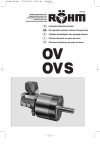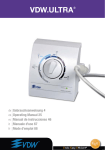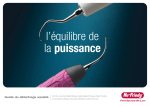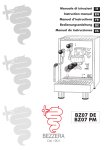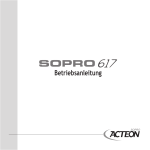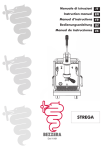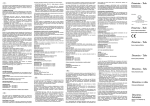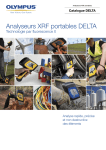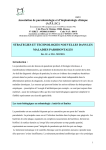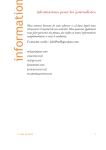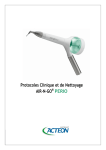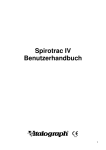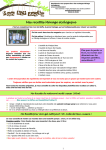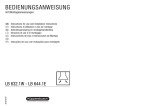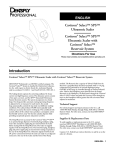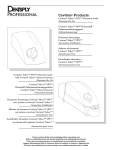Download Cavitron - Dentsply International
Transcript
DENTSPLY® CAVITRON® ULTRASONIC INSERTS DIRECTIONS FOR USE and INFECTION CONTROL PROCEDURES INSERTS ULTRASONIQUES DENTSPLY® CAVITRON® MODE D’EMPLOI et PROCÉDURES DE CONTRÔLE DE L’INFECTION INSERTOS ULTRASÓNICOS DENTSPLY® CAVITRON® INSTRUCCIONES DE USO y PROCEDIMIENTOS PARA EL CONTROL DE INFECCIONES DENTSPLY® CAVITRON® ULTRASCHALL-INSTRUMENTENEINSÄTZE GEBRAUCHSANLEITUNG und INFEKTIONSKONTROLLVERFAHREN INSERTI ULTRASONICI DENTSPLY® CAVITRON® ISTRUZIONI PER L'USO e PROCEDURE DI CONTROLLO DELLE INFEZIONI УЛЬТРАЗВУКОВЫЕ ВКЛАДЫШИ DENTSPLY® CAVITRON® УКАЗАНИЯ ПО ПРИМЕНЕНИЮ и ПРОЦЕДУРЫ ПРОФИЛАКТИКИ ИНФЕКЦИЙ Cavitron • All general supra and subgingival scaling applications. • Periodontal debridement for all types of periodontal diseases. • Endodontic Procedures. • Handle insert with care. Improper handling of insert, specifically the insert tip, may result in injury and/or cross contamination. • It is strongly recommended that this insert be used in accordance with the current CDC Guidelines for Infection Control in dental healthcare settings. • Failure to follow properly validated sterilization processes and approved aseptic techniques for Cavitron inserts may result in cross contamination. CONTRAINDICATIONS • Cavitron inserts should not be used for restorative dental procedures involving condensation of amalgam. WARNING • Tips with high usage which exceed the warranty period should be discarded to avoid possible in-use breakage and possible injury. PRECAUTIONS • It is the responsibilty of the Dental Healthcare Professional to determine the approriate uses of this product and to understand: • The health of each patient; • The dental procedures being undertaken; • The applicable industry and government agency recommendations for the infection control in dental DIRECTIONS FOR USE ENGLISH INDICATIONS FOR USE Cavitron® inserts are to be used with magnetostrictive ultrasonic scalers to perform: 2 system. Use of any other brand ultrasonic equipment with Cavitron equipment has not been tested and may have a negative effect on the safety and effectiveness of your Cavitron equipment and their warranties. Please review the warranty statement enclosed before use. • Like bristles of a toothbrush, ultrasonic inserts “wear” with use. Refer to the Efficiency Wear Indicators supplied with your Cavitron system or insert and the How to Use the Efficiency Indicator section of these Directions for Use. If excessive wear is noted, discard the insert immediately. ADVERSE REACTIONS: None Known. UNIT POWER SETTINGS • PEC, PEC-2, Focused Spray® Slimline®-10S, L&R and Slimline®-10S, L&R inserts should only be used up to medium power. • All other Cavitron inserts may be used up to maximum power. ENGLISH healthcare settings; • The requirements, and regulations for the safe practice of dentistry, and; •These Directions For Use in their entirety. • Operate the inserts only at the recommended power settings. • Check water spray to verify fluid is reaching the working end of the insert tip. Adjust the water lavage control until the water (lavage) flows with a rapid drip or small spray (approximately 35mL). Higher water flow settings provide cooler irrigation. • Do not bend or reshape insert. Inserts should be handled with care at all times. Ultrasonic Inserts tips that have been bent, reshaped or otherwise damaged are susceptible to in-use breakage and should be discarded and replaced immediately. • Cavitron ultrasonic scaling units and Cavitron ultrasonic inserts are designed and tested for safety and efficacy as a 3 ENGLISH INSERT SELECTION Base insert selection on the following: • Patient’s health or disease status. • Root anatomy, considering concavities and furcations. • Type and location of deposits to be removed. For Gross Deposit Removal Classic P, TFI®, and Focused Spray® Powerline™ Inserts For Fine Definitive Debridement Focused Spray Slimline® and Slimline® straight inserts and Cavitron THINsert® for light calculus removal and deplaquing pockets <4 mm deep. Focused Spray Slimline and Slimline® left and right inserts for fine periodontal debridement, excellent access and adaptation to root anatomy in pockets >4 mm deep. 4 For Endodontic Procedures ® PEC and PEC2 Endosonic Inserts used with DENTSPLY Professional Endosonic Files for root canal therapy. OPERATING INSTRUCTIONS 1. Select the appropriate insert for the tooth or root to be treated. 2. Use the lowest effective power setting. 3. Adjust the water control until the water (lavage) flows with a rapid drip or small spray. 4. Use very light pressure with a light pen or modified pen grasp. 5. Use a light but stable intraoral or extraoral fulcrum. 6. Adapt the insert so the point is not directed into root surface. 7. Use a light, smooth gentle touch. 8. Keep the insert tip in motion at all times, using overlapping horizontal, vertical or oblique brush-like strokes. 9. Use the inactivated insert to explore/evaluate root surface. INFECTION CONTROL PROCEDURES WARNINGS • Instruments are not sterile upon receipt and must be sterilized prior to use in accordance with the following instructions. • The use of cleaning and disinfectant solutions is not recommended. INSTRUCTIONS Point of use: Remove excess soil with disposable cloth or paper. Containment and Transportation: Protect instruments from damage. Instruments should be reprocessed as soon as is reasonably practical following use. Instruments left standing wet may stain or corrode. ENGLISH O-RING CARE Before placing the insert into the handpiece, performing the following steps will increase the o-ring life on Cavitron inserts: • Fill entire handpiece with water. • Lubricate o-ring (black or green rubber material) with water. • Gently twist the insert down into the handpiece until the insert is fully seated in place. LIMITATIONS ON PROCESSING • Repeated cleaning and sterilization cycles have minimum effect on these instruments. End of life is normally determined by wear and damage due to use. • Do not use chemical disinfectants prior to sterilization or rapid deterioration of the material may occur. • Cold liquid disinfection/sterilization, chemical vapor sterilization, and dry heat sterilization methods have not been tested or validated for efficacy and are not recommended for use. 5 Cleaning: Automated • May be cleaned using an ultrasonic water bath for 15 minutes. ENGLISH Cleaning: Manual • Rinse all instruments under running water to remove any gross debris. Disinfection: Additional disinfection is not necessary prior to sterilization. Packaging: Place instrument in a paper or paper/plastic steam sterilization pouch. Instruments may be loaded into dedicated instrument trays. Remove Endosonic Files from PEC and PEC2 inserts prior to packaging. Sterilization: Use a steam autoclave. Place bagged instruments into the 6 steam autoclave, paper side up when using a paper/plastic pouch. Gravity Steam Sterilization Full Cycle: Bagged -135°C (275°F) for 3.5 minutes Pre-vacuum Steam Sterilization Full Cycle: Bagged -132°C (270°F) for 3 minutes Alternate Method: Place non-bagged instruments into the steam autoclave and run at the listed cycles. NOTE: Instruments sterilized unbagged should be used immediately. Drying: To dry, use the drying cycle of the autoclave. Set cycle for 20-30 minutes. Maintenance, inspection and testing: • Visually inspect to ensure all contamination is removed. • Visually inspect all o-rings for wear. Replace worn o-rings (Refer to O-Ring Replacement Kit Instructions). Lubricate o-rings with water before use. • Check for distortion, damage and wear (Refer to Efficiency Wear Indicator Instructions). Discard damaged, worn or corroded instruments. HOW TO USE THE EFFICIENCY WEAR INDICATOR 1) For cards with notches, place the insert tip flat against the applicable Insert Tip diagram with the engraved line aligned with the edge of the card. For cards without notches, match the insert to the appropriate graphic. Hold the top of the grip flush against the edge of the wear guide. Rotate the insert so the tip is flat against the card. Red Blue Tip extends beyond blue line Optimal Efficiency Tip touches blue line Reorder Tip touches red line Discard To re-order Inserts, call your local DENTSPLY Professional Distributor or call Customer Service 800-989-8826 ENGLISH Storage: To maintain sterility, instruments should remain bagged until ready for use. 2) Compare length to the red and blue lines. 3) Evaluate tip shape. If shape does not match profile, discard the insert. To order efficiency indicator cards for Cavitron® inserts: Call DENTSPLY Professional Customer Service at 1-800-989-8826. WARRANTY Cavitron® ultrasonic inserts manufactured by DENTSPLY Professional are warranted against defects arising from faulty 7 ENGLISH materials or workmanship for ninety days from the date of purchase. This warranty extends to inserts purchased from an authorized DENTSPLY distributor and only to the original purchaser and is valid only for inserts purchased in the United States (U.S.) and for those countries without specific warranty requirements. For inserts purchased outside the U.S. in countries with specific warranty requirements, those applicable country warranties will apply. This warranty is subject to the following conditions: 1) Inserts must not be subjected to abuse or improper use or application. 2) Inserts must not be subjected to abuse or improper cleaning, disinfection, or sterilization procedures. 3) Bending or reshaping the inserts will void the warranty. 8 4) Using inserts in units other than CAVITRON ultrasonic systems will void the warranty. There are no warranties, expressed or implied beyond the description on the face hereof. DENTSPLY neither assumes, nor authorizes any person to assume for it, any other liability for incidental and consequential damages resulting from the use of the insert. To receive reimbursement for any defective Cavitron ultrasonic insert, you must send the defective product within the warranty period to the dealer or manufacturer with specification of the defect and receipt of purchase. FOR TECHNICAL SUPPORT: Call DENTSPLY PROFESSIONAL PRODUCT SERVICES DEPARTMENT at 1-800-989-8826. MODE D'EMPLOI INDICATIONS Les inserts Cavitron® doivent être utilisés avec des détartreurs ultrasoniques magnétostrictifs afin d’effectuer les procédures suivantes: CONTRE-INDICATIONS Les inserts Cavitron ne doivent pas être utilisés pour des procédures de restauration dentaire nécessitant la condensation d’un amalgame. • Les embouts fortement usagés et dont la période de garantie a expiré doivent être jetés afin d’éviter leur éventuelle cassure en cours d’utilisation et des blessures potentielles. • Manipuler l’insert avec soin. Une mauvaise manipulation de l’insert, en particulier de l’embout, risque de provoquer des blessures et/ou une contamination croisée. • Il est fortement recommandé d’utiliser cet insert conformément aux directives du CDC (“Center for Disease Control”, ou Centre américain de veille sanitaire) relatives au contrôle des infections en cabinet dentaire. • Tout manquement aux procédures de stérilisation validées et aux techniques d’aseptisation homologuées pour les inserts Cavitron risque de provoquer une contamination croisée. FRANÇAIS • Toutes les procédures générales de détartrage sus- et sous-gingival. • Débridement parodontal pour tous les types de maladies parodontales. • Les procédures endodontiques. AVERTISSEMENT 9 FRANÇAIS 10 PRÉCAUTIONS • Il est de la responsabilité du praticien dentaire de déterminer les cas dans lesquels ce produit peut être utilisé, et d’être au fait de : • l’état de santé du patient ; • les procédures de soins dentaires actuellement entreprises; • les recommandations professionnelles et officielles en matière de contrôle des infections dans le cadre des soins dentaires ; • es exigences et la réglementation nécessaires à une pratique sans danger de sa profession ; et • le présent Mode d’emploi dans son intégralité. • Vaporiser un peu d’eau pour s’assurer que le liquide atteint l’extrémité de l’embout de l’insert. Régler le débit de lavage jusqu’à ce que l’eau (de lavage) s’égoutte rapidement ou s’écoule en un mince jet (environ 35 mL). Un débit d’eau plus important entraîne une irrigation plus froide. • Ne pas tordre et ne pas déformer l’insert. Prendre garde à toujours le manipuler avec soin. Les pointes d’insert ultrasonique qui ont été tordues, endommagées ou déformées sont susceptibles de se casser en cours d’utilisation et doivent être jetées et remplacées immédiatement. • Les unités de détartrage à ultra-sons Cavitron et les inserts Cavitron sont conçus et testés pour une utilisation sans danger et un fonctionnement efficace du système. L’utilisation d’un dispositif à ultra-sons d’une autre marque avec le matériel Cavitron n’a pas été testée, des effets néfastes sont donc possibles pour la sécurité et l’efficacité du système Cavitron, ainsi que pour les garanties. Veuillez lire attentivement la déclaration de garantie ci-jointe avant toute utilisation. • Tout comme les poils d’une brosse à dents, les pointes d’insert ultrasonique s’émoussent avec l’usage. Utilisez les indicateurs d’efficacité et d’usure fournis avec votre insert ou votre système Cavitron et consultez la section intitulée « Utilisation des indicateurs d’efficacité » dans ce mode d’emploi. • • L’anatomie des racines, tout en considérant les racines concaves et en fourche. Le type et l’emplacement des dépôts à enlever. Enlèvement des dépôts importants Inserts Classic P, TFI®, et Focused Spray® Powerline™. RÉGLAGES DE LA PUISSANCE DE L’UNITÉ • Les inserts PEC, PEC-2, Focused Spray® Slimline®10S, L&R et Slimline®10S, L&R peuvent être utilisés jusqu’à la puissance moyenne. • Tous les autres inserts Cavitron peuvent être utilisés jusqu’à leur puissance maximale. Débridement définitif (enlèvement des débris fins) Inserts droits Focused Spray® Slimline®, Slimline® et Cavitron THINsert® pour l’enlèvement des petits dépôts et le détartrage des poches d’une profondeur < 4 mm. SÉLECTION DE L’INSERT Sélectionner l’insert en fonction des critères suivants : • État de santé du patient ou de sa maladie. Inserts gauches et droits Focused Spray® Slimline® et Slimline® pour les débridements parodontaux fins, accès excellent et adaptation à l’anatomie des racines dans les poches d’une profondeur > 4 mm. FRANÇAIS EFFETS INDÉSIRABLES: Aucun connu. 11 FRANÇAIS 12 INSTRUCTIONS 1. Sélectionner l’insert approprié pour la dent ou la racine à traiter. 2. Utiliser un réglage de puissance efficace le plus bas possible. 3. Régler le débit d’eau afin que l’eau de lavage sorte sous forme d’un goutte-à-goutte rapide ou d’un petit aérosol. 4. Appliquer une très légère pression en le tenant comme ou presque comme un crayon. 5. Utiliser un point d’appui intra-buccal ou extra-buccal léger mais stable. 6. Positionner l’insert de façon à ce que l’extrémité ne soit pas dirigée vers l’intérieur des racines. 7. Utiliser un doigté léger, doux et modéré. 8. Garder la pointe de l’insert en mouvement continu, en brossant avec des mouvements, superposés horizontalement, verticalement ou obliquement. 9. Utiliser l’insert inactivé pour examiner/évaluer les racines dentaires. ENTRETIEN DES JOINTS EN “O” En procédant selon les étapes suivantes avant de placer l’insert dans la pièce à main, vous prolongerez la durée de vie du joint sur les inserts Cavitron : • • • PROCÉDURES DE CONTRÔLE DES INFECTIONS AVERTISSEMENTS • Lorsqu’ils sont livrés, les instruments ne sont pas stériles et doivent être stérilisés avant toute utilisation, conformément aux instructions ci-après. • L'utilisation de solutions nettoyantes et aseptisantes n'est pas recommendée. RESTRICTIONS SUR LE TRAITEMENT • Des cycles de nettoyage et de stérilisation répétés ont un effet minimum sur ces instruments. La fin de leur cycle de vie est en principe déterminée par l'usure et les dégâts dus à l'utilisation. • Ne pas utiliser de désinfectants chimiques avant la stérilisation, faute de quoi une détérioration rapide du matériel peut se produire. • Les méthodes de désinfection/stérilisation à liquide froid, à vapeur chimique, et à chaleur sèche n'ont pas été testées ou validées pour leur efficacité. Par conséquent, leur utilisation n'est pas recommandée. INSTRUCTIONS Zone de soin : Enlever l'excès de saleté à l'aide d'un tissu ou d'un papier jetable. Confinement et transport : Protèger les instruments de toute destruction. Les instruments FRANÇAIS Remplir toute la pièce à main avec de l'eau. Lubrifier le joint en O (en caoutchouc noir ou vert) avec de l’eau. Tourner lentement l'insert vers le bas, à l'intérieur de la pièce à main, jusqu'à ce que celui-ci soit complètement enfoncé. 13 FRANÇAIS doivent être traités à nouveau dès qu'il est raisonnablement pratique de le faire après leur utilisation. Les instruments mouillés peuvent se tacher ou se corroder. papier pour stérilisation à vapeur. Les instruments peuvent être chargés dans des plateaux prévus à cet effet. Nettoyage : Automatique • Peut être nettoyé à l'aide d'un bain à l'eau ultrasonique pendant 15 minutes. Stérilisation: Utiliser un autoclave à vapeur. Disposer les instruments ensachés dans l’autoclave ; si le sachet de stérilisation est en plastique et en papier, le mettre avec la paroi en papier orientée vers le haut. Nettoyage : Manuel • Rincer tous les instruments sous de l'eau courante pour enlever tout débris. Stérilisation à la vapeur et par gravité Cycle entier : 135° C (275° F) pendant 3,5 minutes Désinfection : Une désinfection supplémentaire n'est pas nécessaire avant la stérilisation. 14 Conditionnement : Mettre l’instrument dans un sachet en papier ou en plastique/ Stérilisation à la vapeur avec vide préalable Cycle entier : 132° C (270° F) pendant 3 minutes Autre méthode : disposer les instruments non ensachés dans l’autoclave et lancer les cycles indiqués. REMARQUE. Si les instruments ne sont pas ensachés, ils doivent être utilisés immédiatement après leur stérilisation. Séchage : Pour sécher, utiliser le cycle de séchage de l’autoclave. Régler le cycle pendant 20 à 30 minutes. UTILISATION DES INDICATEURS D’EFFICACITÉ ET D’USURE 1) Dans le cas d’indicateurs d’usure avec encoches, placer la pointe de l’insert à plat contre le schéma approprié de pointe d’insert, en prenant soin d’aligner la ligne gravée avec le bord de la carte. Dans le cas d’indicateurs d’usure sans encoche, faites correspondre l’insert au graphique approprié. Maintenez le haut de la poignée de libération au contact du témoin d’usure. Faites tourner l’insert de manière à ce qu’il soit bien positionné en face de la carte. Examinez la forme de l’insert et comparez-la au graphique. FRANÇAIS Entretien, contrôle et test : • Effectuer un contrôle visuel pour s'assurer que toutes les contaminations sont éliminées. • Faire de même avec les joints en “O” pour déterminer le degré d’usure ; remplacer les joints défectueux (Consulter les instructions du kit de remplacement d’anneaux toriques). Lubrifier les joints avec de l’eau avant toute utilisation. • Vérifier toute déformation, destruction et usure (Consulter les instructions des indicateurs d’efficacité et d’usure). Jetez les instruments endommagés, usés, ou corrodés. Conservation : Pour conserver leur stérilité, les instruments doivent rester ensachés jusqu'à ce qu'ils soient prêts à l'emploi. 15 2) Comparer la longueur avec la ligne rouge et la ligne bleue. 3) Évaluer la forme de la pointe. Si la forme est différente du profil, jetez l’insert. FRANÇAIS Rouge 16 Bleu Le bout dépasse la ligne bleue. Efficacité optimale Le bout touche la ligne bleue. Commande à faire Le bout touche la ligne rouge. Jeter Pour commander des inserts, appeler votre distributeur local DENTSPLY Professional ou appeler notre service clients au 1-800-989-8826 Pour commander des fiches d’indicateur d’efficacité pour les inserts Cavitron®, veuillez appeler le service à la clientèle de DENTSPLY Professional au 1-800-989-8826 GARANTIE Les inserts ultrasoniques Cavitron® fabriqués par DENTSPLY Professional sont garantis contre toutes défectuosités matérielles ou de main d’œuvre pendant quatre-vingt dix jours à compter de la date d’achat. Cette garantie ne concerne que les produits achetés auprès d’un distributeur agréé de DENTSPLY; cette garantie ne s’adresse qu’au premier acquéreur et n’est valide que pour les inserts achetés aux États-Unis (U.S.A) et dans les pays sans obligations spécifiques de garantie. Pour les inserts achetés hors des États-Unis dans des pays qui prévoient des règles de garantie spécifiques, les garanties applicables au pays prévalent. Cette garantie est soumise aux conditions suivantes : 1) les inserts ne doivent pas avoir subi de dégâts ou avoir été l’objet d’une mauvaise installation ou utilisation ; 2) les inserts ne doivent pas avoir subi de dégâts ou avoir été l’objet de ifiques de es pays qui plicables au é l’objet é l’objet de 4) la garantie ne sera pas honorée pour des inserts utilisés avec des systèmes autres que les systèmes ultrasoniques Cavitron. Aucune garantie, implicite ou explicite, ne pourra être consentie en dehors des clauses indiquées ci-dessus. DENTSPLY n’endosse, ni n’autorise à quiconque d’endosser d’autre responsabilité pour tout dégât indirect et consécutif résultant d’une mauvaise utilisation de l’insert. Pour obtenir le remboursement de tout insert ultrasonique Cavitron défectueux, vous devez envoyer le produit défectueux pendant la période couverte par la garantie au revendeur ou fabricant en joignant une fiche explicative du problème ainsi que le reçu de l’achat. POUR TOUTE ASSISTANCE TECHNIQUE : Pour toute assistance technique, veuillez contacter votre représentant local de DENTSPLY. FRANÇAIS Professional ain d’œuvre Cette garanteur agréé uéreur et procédures de nettoyage, de désinfection ou de stérilisation incorrectes ; 3) tous inserts tordus ou déformés par leur utilisateur annuleront la garantie ; 17 ESPAÑOL MODO DE EMPLEO 18 INDICACIONES Los insertos Cavitron® deben emplearse con escarificadores ultrasónicos magnetoestrictivos para realizar: • Todas las aplicaciones generales supra y subgingivales para escarificación. • Desbridamiento periodontal para todo tipo de enfermedades periodontales. • Procedimientos de endodoncia. CONTRAINDICACIONES • Los insertos Cavitron no deberán emplearse en procedimientos de restauración dental en los cuales haya condensación de amalgamas. ADVERTENCIA • Las puntas que se usen mucho y sobrepasen el período de garantía deben desecharse para evitar posibles lesiones y roturas durante su uso. • Manipule el inserto Cavitron con cuidado. Si se manipula inadecuadamente, específicamente la punta del inserto, es posible que se produzcan lesiones y/o contaminación cruzada. • Se recomienda que este inserto sea utilizado de acuerdo con la normativa CDC (Centros para el Control y Prevención de Enfermedades de los Estados Unidos) actual sobre el control de infecciones en entornos odontológicos. • Si no se siguen adecuadamente los procesos de esterilización validados y las técnicas asépticas aprobadas para los insertos Cavitron, es posible que se produzca contaminación cruzada. boquillas de los insertos ultrasónicos que se hayan doblado, dañado o deformado son susceptibles a sufrir fracturas durante el uso, por lo que deberán desecharse y sustituirse inmediatamente. • Las unidades de escarificación ultrasónica Cavitron y los insertos ultrasónicos Cavitron están diseñados y probados como un sistema para que funcionen con seguridad y eficacia. No se ha probado el uso de un equipo ultrasónico de distinta marca junto con el equipo Cavitron. Si esto sucede, es posible que se produzcan efectos negativos en la seguridad, la efectividad y la garantía de los equipos Cavitron. Consulte la garantía que se adjunta con el equipo antes de utilizarlo. • Como las cerdas de un cepillo de dientes, las puntas de los insertos ultrasónicos de “desgastan” con el uso. Consulte los indicadores de desgaste de eficacia, incluidos con el inserto o el sistema Cavitron, y la sección Cómo utilizar el indicador de eficacia de estas Instrucciones de uso. ESPAÑOL PRECAUCIONES • El profesional de la odontología tiene la responsabilidad de determinar el uso de este producto de manera adecuada y de conocer: • la salud de los pacientes; • los procedimientos dentales que realiza; • las recomendaciones aplicables de organismos profesionales y gubernamentales sobre el control de infecciones en entornos odontológicos; • los requisitos y las normas para la práctica segura de la odontología; y • estas Instrucciones de uso en su totalidad. • Verifique la pulverización de agua para comprobar si el líquido llega a la punta del inserto. Ajuste el control de lavado hasta que el agua (de lavado) fluya con un goteo o algo de pulverización (aproximadamente 35 ml). Una mayor graduación de flujo proporciona una irrigación más fría. • No doble o cambie la forma del inserto. Los insertos deberían manejarse con cuidado en todo momento. Las 19 ESPAÑOL REACCIONES ADVERSAS: No se han descito. 20 CALIBRACIÓN DE LA POTENCIA DE LA UNIDAD • Los insertos PEC, PEC-2, Focused Spray® Slimline®10S, L&R y Slimline®10S, L&R deben emplearse sin sobrepasar la potencia media. • Todos los demás insertos pueden emplearse a una potencia máxima. SELECCIÓN DEL INSERTO La selección del inserto se basa en los siguientes criterios: • Estado de salud o enfermedad del paciente • Anatomía radicular, tomando en cuenta las concavidades y bifurcaciones • Tipo y ubicación de los depósitos que se deben eliminar Para la eliminación de depósitos de residuos gruesos Insertos Classic P, TFI®, y Focused Spray® Powerline™ Para el desbridamiento definitivo de residuos finos Insertos rectos FSI® Slimline®, Slimline® y Cavitron THINsert® para la extracción de cálculos ligeros y para eliminar la placa de cavidades de <4 mm de profundidad. Los insertos FSI® Slimline y Slimline® izquierdo y derecho para el desbridamiento periodontal, y para un acceso y adaptación óptimos a la anatomía radicular en cavidades de >4 mm de profundidad. INSTRUCCIONES DE FUNCIONAMIENTO 1. Seleccione el inserto adecuado para el diente o raíz que se va a tratar. 2. Siempre que sea posible utilice el nivel de potencia más bajo. 3. Ajuste el control de agua hasta que el agua (de lavado) fluya 7. Haga contacto de forma suave y ligera. 8. Mantenga en movimiento continuo la punta del inserto, como si diera pinceladas con movimientos repetitivos horizontales, verticales y oblicuos. 9. Use el inserto inactivo para explorar o evaluar la superficie dental. CUIDADO DE ARANDELAS Antes de colocarla en la pieza de mano, siga los pasos siguientes para aumentar la vida útil de la arandela de los insertos Cavitron: • Llene de agua toda la pieza de mano. • Lubrique con agua la arandela (goma negra o verde). • Presione y gire suavemente el inserto hasta que encaje totalmente en la pieza de mano. ESPAÑOL con un goteo rápido o algo de pulverización. 4. Aplique una presión suave con un lápiz ligero o instrumento similar. 5. Utilice un punto de apoyo ligero pero estable intraoral o extraoral. 6. Manipule el inserto de manera que la punta no esté dirigida hacia la superficie del implante. PROCEDIMIENTOS DE CONTROL DE INFECCIONES ADVERTENCIAS • Los instrumentos no vienen esterilizados de fábrica, por lo que deben esterilizarse antes de su uso siguiendo las instrucciones que aparecen a continuación. 21 ESPAÑOL • No se recomienda el uso de soluciones limpiadoras o desinfectantes. 22 RESTRICCIONES • La repetición continua de las tareas de limpieza y esterilización tiene un efecto mínimo en estos instrumentos. Generalmente, el fin de su vida útil se debe al desgaste o los daños sufridos por el uso. • No utilice desinfectantes químicos antes de la esterilización, ya que podrían acelerar el deterioro del material. • La eficacia de los métodos de esterilización/desinfección con líquidos fríos, esterilización con vapores químicos y esterilización con calor seco no ha sido probada ni validada, por lo que no se recomienda su uso. INSTRUCCIONES Lugar de aplicación Elimine el exceso de residuos con papel o paños desechables. Conservación y transporte Proteja los instrumentos para evitar que se dañen. Los instrumentos deben desinfectarse tan pronto como sea posible tras su uso. Si se dejan húmedos, es posible que los instrumentos se corroan o que aparezcan manchas. Limpieza: Automática • Puede limpiarse con un baño de agua ultrasónico de 15 minutos. Limpieza: Manual • Enjuague todos los instrumentos con un chorro de agua para eliminar cualquier resto visible. Desinfección No es necesaria una desinfección adicional antes de la esterilización. Envoltura Coloque el instrumento en una bolsa para esterilización con vapor de papel o de papel y plástico. Los instrumentos pueden colocarse en bandejas destinadas a tal efecto. Esterilización con Vapor por método de Gravedad Ciclo Completo: 135 °C (275 °F) durante 3,5 minutos Esterilización con Vapor por método de Vacío previo Ciclo Completo: 132 °C (270 °F) durante 3 minutos Método Alternativo: Coloque los instrumentos sin bolsa en la autoclave de vapor y ejecute los ciclos indicados. Secado Para secar, utilice el ciclo de secado del autoclave. Establezca una rutina de 20-30 minutos. Mantenimiento, inspección y pruebas • Haga una inspección visual para asegurarse de que se ha eliminado toda contaminación posible. • Haga una inspección visual de las arandelas y cámbielas si están desgastadas (Consulte las instrucciones para el kit de arandelas de repuesto). Lubrique con agua las arandelas antes de su uso. • Compruebe que no hay deformaciones, daños o desgaste (Consulte las instrucciones del indicador de desgaste de eficacia). Deseche los instrumentos que estén dañados, desgastados o corroídos. ESPAÑOL Esterilización: Utilice un autoclave de vapor. Coloque los instrumentos envueltos en el autoclave de vapor. Si utiliza una bolsa para esterilización con vapor de papel y plástico ponga el lado de papel hacia arriba. NOTA: Los instrumentos esterilizados sin bolsa deben utilizarse inmediatamente. 23 Almacenamiento Para mantener la esterilidad, los instrumentos deben permanecer envueltos hasta que estén listos para su uso. ESPAÑOL INDICADOR CÓMO UTILIZAR EL INDICADOR DE DESGASTE DE EFICACIA 24 1) Para los Indicadores de Desgaste con muescas, fije la punta del inserto según se indica en el diagrama de la punta del inserto correspondiente, con la línea en relieve alineada con el borde de la tarjeta. Para los Indicadores de Desgaste sin muescas, haga coincidir la boquilla con el gráfico correspondiente. Sostenga la parte superior de la empuñadura contra el borde de la guía de desgaste. Gire la boquilla para que la punta quede plana contra la tarjeta. Para evaluar la forma de la boquilla, compárela con el gráfico. 2) Compare la longitud con las líneas rojas y azules. 3) Evalúe la forma de la punta. Si no coincide con el perfil, deseche el inserto. Rojo Azul La punta sobrepasa la línea azul Eficacia óptima La punta toca la línea azul Realizar un pedido nuevo La punta toca la línea roja Desechar Para pedir insertos, póngase en contacto con su distribuidor local de DENTSPLY Professional o llame al servicio de atención al cliente al 800-989-8826. Para pedir tarjetas indicadoras de eficacia de los insertos Cavitron®: llame al servicio de atención al cliente DENTSPLY Professional al 1-800-989-8826. GARANTÍA Los insertos ultrasónicos Cavitron® fabricados por DENTSPLY Professional están garantizados contra materiales defectuosos o defectos de fabricación durante noventa días desde la fecha de compra. Esta garantía cubre los productos comprados en Las únicas garantías, expresas o implícitas que se otorgan son las que se describen en este texto. DENTSPLY no asume ni autoriza a ninguna persona a que asuma en su nombre ninguna otra responsabilidad por daños fortuitos o consiguientes a causa del uso del inserto. Para recibir reembolso por cualquier inserto ultrasónico Cavitron defectuoso, debe enviar el producto defectuoso dentro del periodo de garantía al distribuidor o fabricante con la especificación del defecto y el recibo de compra. ASISTENCIA TÉCNICA Para obtener asistencia técnica, contacte al distribuidor local de DENTSPLY. ESPAÑOL un distribuidor DENTSPLY autorizado. Solo se extiende al comprador original y es válida únicamente para los insertos comprados en Estados Unidos (EE. UU.) y en aquellos países sin requisitos específicos de garantía. Esta garantía se aplica solo al comprador original y es válida solo para los insertos adquiridos en Estados Unidos (EE. UU.) y para aquellos países sin requisitos específicos de garantía. Para los insertos adquiridos fuera de Estados Unidos en países con requisitos específicos de garantía, se aplicarán las garantías aplicables del país. Esta garantía está regida por las siguientes condiciones: 1) Los insertos no deben utilizarse de forma abusiva ni ser utilizados o aplicados en condiciones incorrectas 2) Los insertos no deben someterse a procedimientos incorrectos de limpieza, desinfección ni esterilización 3) Se anulará la garantía al doblar o deformar los insertos. 4) Se anulará esta garantía al emplear los insertos en otras unidades que no sean sistemas ultrasónicos Cavitron. 25 DEUTSCH GEBRAUCHSANWEISUNG 26 INDIKATIONEN Cavitron®-Einsatzstücke müssen mit magnetostriktiven Ultraschall-Zahnsteinentfernungsgeräten verwendet werden. Dies gilt für: • alle allgemeinen Anwendungen zur Entfernung supra- und subgingivalen Zahnsteins • Periododontale Mundreinigung bei allen Arten periodontaler Erkrankungen • endodontische Verfahren KONTRAINDIKATIONEN • Cavitron-Einsatzstücke dürfen nicht bei wiederherstellenden zahnmedizinischen Verfahren verwendet werden, bei denen es zur Kondensierung von Amalgam kommt. WARNHINWEISE • Bei starker Nutzung sind die Einsätze nach Ablauf der Gewährleistungszeit zu entsorgen, um mögliche Brüche während der Verwendung sowie daraus resultierende Verletzungen zu vermeiden. • Einsatz vorsichtig behandeln. Unsachgemäße Handhabung des Einsatzes, insbesondere der Einsatzspitze, kann zu Verletzungen und/oder Kreuzkontamination führen. • Es wird nachdrücklich empfohlen, dass dieser Einsatz nur in Übereinstimmung mit den gültigen Verordnungen der Gesundheitsbehörde zur Infektionskontrolle in zahnärztlichen Einrichtungen verwendet wird. • Nichtbeachtung der ordnungsgemäßen Sterilisationsverfahren und zugelassenen aseptischen Techniken für Cavitron-Einsätze kann zur Kreuzkontamination führen. • • • Den Einsatz bitte nicht verbiegen oder verformen. Einsätze müssen immer mit Sorgfalt gehandhabt werden. Spitzen von Ultraschalleinsätzen, die verbogen, beschädigt oder verformt worden sind, können während der Verwendung brechen und müssen sofort entsorgt und ersetzt werden. Cavitron-Ultraschallscaler und Cavitron UltraschallEinsätze wurden auf Sicherheit und Wirksamkeit als System entwickelt und getestet. Die Verwendung anderer Ultraschallgeräte mit Cavitron-Instrumenten wurde nicht getestet und deren Anwendung kann sich negativ auf die Sicherheit und Effektivität Ihrer Cavitron-Ausrüstung und deren Garantie auswirken. Bitte lesen Sie vor der Verwendung des Gerätes die Garantieerklärung. Ähnlich wie die Borsten einer Zahnbürste verschleißen auch die Ultraschall-Einsatzspitzen im Laufe des Gebrauchs. Sehen Sie hierzu die Leistungsindikatoren, die mit Ihrem Cavitron System oder den Einsätzen geliefert wurden sowie die Anleitung zur Nutzung der Leistungsindikatoren in dieser Gebrauchsanleitung. DEUTSCH VORSICHTSMAßNAHMEN • Es obliegt der Verantwortung von Zahnärzten und Zahnarzthelfern, Entscheidungen über den adäquaten Einsatz dieses Produkts zu treffen sowie die folgenden Punkte und Fakten zu kennen: • den Gesundheitszustand des Patienten • die durchzuführenden zahnärztlichen Verfahren • die einschlägigen branchenmäßigen und behördlichen Empfehlungen zur Infektionskontrolle in zahnärztlichen Einrichtungen • die Anforderungen und Bestimmungen zur sicheren Praxis der Zahnheilkunde sowie • diese Gebrauchsanweisung in ihrer Gesamtheit. • Den Wassersprüher kontrollieren, um sicherzustellen, dass die Wasserspülung die Einsatzspitze erreicht. Den Lavageregler so einstellen, dass das Wasser (Lavage) in schnellen Tropfen fließt oder leicht spritzt (ca. 35 ml). Durch einen höheren Wasserfluss wird eine kühlere Spülung erzielt. 27 DEUTSCH NEBENWIRKUNGEN: Keine bekannt. 28 EINSTELLUNGEN FÜR DAS GERÄT • PEC, PEC-2, Focused Spray® Slimline®10S, L&R, Slimline®10S und L&R Einsatzstücke sollten bis zur mittleren Stufe eingesetzt werden. • Alle anderen Cavitron Einsatzstücke können bis zur maximalen Stufe eingesetzt werden. WAHL DES EINSATZSTÜCKS Die Wahl des Einsatzstücks richtet sich nach: • Gesundheits- bzw. Krankheitszustand des Patienten • Wurzelanatomie unter Berücksichtigung von Krümmungen und Gabelungen • Art und Stelle der zu entfernenden Ablagerungen Für die Entfernung grober Ablagerungen Classic P, TFI® und Focused Spray® Powerline™ Einsätze Für die abschließende Feinreinigung Gerade Einsatzstücke vom Typ Focused Spray® Slimline®, Slimline® und Cavitron THINsert® für die Entfernung von leichtem Zahnstein und Zahnbelag in <4 mm tiefen Taschen. Linke und rechte Einsatzstücke vom Typ Focused Spray® Slimline® und Slimline® für die abschließende Feinreinigung; bietet ausgezeichneten Zugang und Anpassung an die Anatomie der Wurzel in >4 mm tiefen Taschen. BETRIEBSANWEISUNGEN 1. Das richtige Einsatzstück für den zu behandelnden Zahn oder die Wurzel auswählen. 2. Die niedrigste noch wirksame Leistungsstufe verwenden. 3. Die Wasserkontrolle einstellen, bis das Wasser (bzw. die O-RING-PFLEGE Vor dem Aufstecken des Einsatzes in das Handstück sind die folgenden Schritte auszuführen, damit die Lebensdauer des O-Rings auf Cavitron Einsätzen verlängert wird: • • • 7. Leichte, sanfte und gleichmäßige Bewegungen ausführen. 8. Die Spitze des Einsatzstücks kontinuierlich mit horizontal vertikalen oder schräg übergreifenden, bürstenartigen Strichen in Bewegung halten. 9. Das nicht aktivierte Einsatzstück zur Sondierung/ Beurteilung der Wurzeloberfläche verwenden. Füllen Sie das gesamte Handstück mit Wasser. O-Ring (schwarzes oder grünes Gummimaterial) mit Wasser befeuchten. Den Einsatz vorsichtig in das Handstück drehen, bis er vollständig eingesetzt ist. DEUTSCH Spülung) fein versprüht wird. 4. Nur sehr leicht andrücken, Gerät wie einen Stift halten. 5. Eine leichte, aber stabile intraorale oder extraorale Stütze verwenden. 6. Einsatzstück so ansetzen, so dass die Spitze nicht auf die Zahnwurzeloberfläche trifft. VERFAHREN ZUR INFEKTIONSKONTROLLE WARNHINWEISE • Die Instrumente sind nach Empfang nicht steril und müssen vor Gebrauch den nachfolgenden Anweisungen entsprechend sterilisiert werden. 29 DEUTSCH • Es empfiehlt sich nicht, Reinigungs- und Desinfektionsmittellösungen zu verwenden. 30 EINSCHRÄNKUNGEN • Wiederholte Reinigungs- und Sterilisationszyklen haben nur geringe Wirkung auf diese Instrumente. Die Lebensdauer wird üblicherweise durch Abnutzung und Schäden durch Gebrauch bestimmt. • Vor Sterilisation keine chemischen Desinfektionsmittel verwenden, weil dadurch das Material beschädigt werden kann. • Die Methoden der Desinfektion/Sterilisation mit Kaltflüssigkeit, der chemischen Dampfsterilisation und der Sterilisation durch Trockenluft wurden auf Wirksamkeit nicht getestet oder geprüft und werden nicht empfohlen. ANWEISUNGEN Verwendungsstelle: Verschmutzungen mit Wegwerftuch oder -papier entfernen. Umfassung und Transport: Geräte vor Beschädigung schützen. Instrumente müssen nach Gebrauch so schnell wie praktisch möglich wiederaufbereitet werden. Instrumente können verfärben oder korrodieren, wenn sie nass stehen gelassen werden. Reinigung: Automatisiert Kann unter Verwendung eines Ultraschallwasserbads für 15 Minuten gereinigt werden. Reinigung: Manuell Alle Instrumente unter fließendem Wasser spülen, damit grobe Überreste entfernt werden. Desinfektion: Zusätzliche Desinfektion vor der Sterilisation ist nicht notwendig. Verpackung: Instrumente in einen Papier- oder Papier-/Plastikbeutel für Dampfsterilisierung legen. Instrumente auf dazu geeignete Instrumententabletts laden. Sterilisation: Verwenden Sie einen Dampfautoklaven. Legen Sie die in Beutel gefüllten Instrumente in den Dampfautoklaven; bei Verwendung von Papier/Plastikbeuteln mit Papierseite nach oben. Vorvakuum-Dampfsterilisation Vollständiger Zyklus: 132°C (270°F) für 3 Minuten Alternativmethode: Legen Sie die Instrumente ohne Beutel in den Autoklaven und führen Sie die angegebenen Zyklen durch. HINWEIS. Nicht in Beuteln sterilisierte Instrumente sollten sofort verwendet werden. Trocknen: Zum Trocknen verwenden Sie den Trockenzyklus des Autoklaven. Den Trockenzyklus auf 20-30 Minuten einstellen. Aufbewahrung: Instrumente müssen zur Bewahrung der Sterilität bis zur Anwendung in Beuteln aufbewahrt werden. DEUTSCH Schwerkraft-Dampfsterilisation Vollständiger Zyklus: 135 °C (275 °F) für 3,5 Minuten Wartung und Überprüfung: • Optisch überprüfen, um sicherzustellen, dass die Kontamination vollständig entfernt ist. • Optisch alle O-Ringe auf Abnutzung überprüfen. Abgenutzte O-Ringe ersetzen (siehe Anleitungen zum Ersatz der O-Ringe). Benetzen Sie die O-Ringe vor Gebrauch mit Wasser. • Auf Verformung, Schaden oder Abnutzung überprüfen (siehe Anleitungen zu den Leistungsindikatoren). Beschadete, abgenutzte oder korrosive Instrumente entsorgen. ZUR BENUTZUNG DER LEISTUNGSINDIKATOREN 1) Für Leistungsindikatoren mit Kerben, halten Sie die Einsatzspitze flach gegen das passende Einsatzspitzendiagramm, wobei 31 die markierte Linie an den Rand der Karte angelegt werden DEUTSCH sollte. Für Leistungsindikatoren ohne Kerben, lokalisieren Sie die entsprechende Grafik für das Einsatzstück Halten Sie die Griffoberseite bündig gegen die Kante des Abnutzungsprüfers. Drehen Sie das Einsatzstück, sodass die Spitze flach an der Karte ruht. Beurteilen Sie die Form des Einsatzstücks anhand der Grafik. 2) Vergleichen Sie die Länge der roten und blauen Linien. 3) Bewerten Sie die Spitzenform. Wenn die Form nicht dem Profil entspricht, Einsatzstück entsorgen. Rot Blau Spitze reicht über blaue Linie hinaus Optimal Spitze berührt blaue Linie Neu bestellen Spitze berührt rote Linie Entsorgen Weitere Einsatzstücke können von Ihrem regionalen DENTSPLY Professional Distributor bestellt werden. 32 GARANTIE Die Garantie für Cavitron® Ultraschalleinsätze gilt für Schäden durch fehlerhaftes Material oder Defekte in der Herstellung für 90 Tage ab Kaufdatum. Die Garantie umfasst Einsätze, die von einem autorisierten DENTSPLY Vertragspartner vertrieben wurden, ausschließlich für den Erstkäufer und nur in den USA oder in Ländern, welche die spezifischen Garantieanforderungen erfüllen. Für außerhalb der USA gekaufte Einsatzstücke gelten die Garantiebestimmungen des jeweiligen Landes. Die vorliegende Garantie unterliegt folgenden Bestimmungen: 1) Einsatzstücke dürfen keinem Missbrauch, unsachgemäßer Handhabung oder Anwendung ausgesetzt werden. 2) Einsatzstücke dürfen keinem Missbrauch oder unsachgemäßen Reinigungs-, Desinfektions-, oder Sterilisationsverfahren ausgesetzt werden. mmungen: hgemäßer nsa 3) Verbiegen oder Verformen führt zum Erlöschen ihrer Garantie. 4) Die Verwendung von Einsatzstücken in anderen Einheiten als Cavitron Ultraschall-Systemen führt zum Erlöschen dieser Garantie. Es bestehen keine ausdrücklichen oder implizierten Garantieleistungen, die sich über die hier beschriebenen Leistungen hinaus erstrecken. DENTSPLY übernimmt keine andere Haftung infolge Neben- oder Folgeschäden in Verbindung mit der Benutzung dieser Einheit und ermächtigt auch keine andere Person, diese an ihrer Stelle zu übernehmen. Um Rückerstattung für fehlerhafte Cavitron Ultraschalleinsätze zu erhalten, müssen Sie das fehlerhafte Produkt, eine detaillierte Beschreibung des Fehlers und den Lieferschein innerhalb der Garantiefrist an den Händler oder Hersteller zurücksenden. TECHNISCHE UNTERSTÜTZUNG: Für technische Unterstützung setzen Sie sich bitte mit Ihrer DENTSPLY-Vertretung vor Ort in Verbindung. DEUTSCH r Schäden stellung für ze, die von rieben wurn USA oder erungen cke gelten 33 ITALIANO ISTRUZIONI PER L’USO INDICAZIONI Gli inserti Cavitron® vanno usati con i sistemi di detartrasi ultrasonici a magnetostrizione per eseguire: • ogni trattamento di ablazione del tartaro sopragengivale e sottogengivale; • curettaggio parodontale adatto a ogni tipo di problema parodontale; • procedure endodontiche. CONTROINDICAZIONI • Gli inserti Cavitron non devono essere usati nelle procedure di ricostruzione con condensazione di amalgama. 34 AVVERTENZE • Le punte ad alto utilizzo che superano il periodo di garanzia vanno eliminate per evitare rotture durante l’utilizzo e possibili lesioni. • Maneggiare l’inserto con cura. Se l’inserto, e in particolare la punta dell’inserto, viene maneggiato in modo inadeguato si possono provocare lesioni e/o contaminazione incrociata. • Si raccomanda caldamente di utilizzare l’inserto conformemente alle attuali normative CDC (Centers for Disease Control and Prevention, centri statunitensi per il controllo delle malattie e prevenzione) sul controllo delle infezioni in ambito odontoiatrico. • La mancata osservanza di processi di sterilizzazione appropriatamente convalidati e di tecniche asettiche approvate per gli inserti Cavitron può causare contaminazione incrociata. • Non piegare e non deformare l’inserto. Gli inserti devono essere sempre maneggiati con cura. Le punte di inserti per ablatori ad ultrasuoni piegate, danneggiate o deformate rischiano di rompersi durante l’utilizzo e devono perciò essere eliminate e sostituite immediatamente. •LeunitàdidetartrasiadultrasuoniCavitronegliinsertiad ultrasuoni Cavitron sono progettati e testati come sistema sicuroedeficace.L’usodiapparecchiatureadultrasuoni di qualsiasi altro marchio con apparecchiature Cavitron non è stato testato e può determinare effetti negativo sulla sicurezzaesull’eficaciadelleapparecchiatureCavitron, oltrechesullerelativegaranzie.Primadell’uso,leggerele dichiarazione di garanzia allegata. • Gli inserti ultrasonici si consumano allo stesso modo di qualsiasi spazzolino da denti. Consultare l’inserto sugli Indicatori di usura dell’efficienza dell’inserto, fornito con il sistema o l’inserto Cavitron, e la sezione relativa all’Utilizzo dell’indicatore di efficienza di queste Istruzioni per l’uso. ITALIANO PRECAUZIONI GENERALI • È responsabilità del professionista dentale determinare gli usi appropriati di questo prodotto e di conoscere: • lo stato di salute del paziente • le procedure dentali che sono intraprese; • le raccomandazioni applicabili dell’industria e delle agenzie governative nei confronti del controllo delle infezioni in ambito odontoiatrico; • i requisiti e le norme per la pratica sicura dell’odontoiatria; e • le presenti istruzioni per l’uso nella loro interezza. • Controllarelanebulizzazionedell’acquaperveriicare che il liquido raggiunga l’estremità operativa della punta dell’inserto. Regolare il controllo del lavaggio ad acqua afinchél’acqua(lavaggio)scorraconunlussorapido oconunaminuscolanebulizzazione(circa35ml).Le impostazioniconlussod’acquamaggioreforniscono un’irrorazione più fredda. 35 ITALIANO REAZIONI AVVERSE: Sconosciute. 36 IMPOSTAZIONE DELLA POTENZA DEL SISTEMA • Gli inserti PEC, PEC-2, Focused Spray® Slimline®10S, L&R e Slimline®10S, L&R devono essere usati solo a media o minore potenza. • Tutti gli altri inserti Cavitron possono essere usati a potenza massima. SELEZIONE DEL TIPO DI INSERTO Scegliere il tipo d’inserto in base a: • Salute del paziente o stato della malattia. • Anatomia della radice, tenendo conto delle concavità e numero delle singole radici. • Tipo e ubicazione del deposito da rimuovere. Per la rimozione di grossi depositi Inserti Classic P, TFI® e Focused Spray® Powerline™ Per il curettaggio accurato definitivo Inserti diritti Focused Spray® Slimline®, Slimline®, e Cavitron Focused Spray® THINsert® per la rimozione di depositi di tartaro leggeri e deplaccaggio di tasche di profondità <4 mm. Inserti sinistro e destro Focused Spray® Slimline® e Slimline® per un accurato curettaggio parodontale, un accesso e adattamento ottimali all’anatomia delle radici in tasche di profondità >4 mm. ISTRUZIONI DI FUNZIONAMENTO 1. Selezionare l’inserto più adatto per il dente o la radice da trattare 7. Applicare un tocco leggero e delicato 8. Mantenere la punta dell’inserto in continuo movimento, con vibrazioni a mo’ di spazzola orizzontali, verticali od oblique e sovrapposte 9. Usare l’inserto allo stato inattivo per esplorare/ valutare la superficie del dente CURA DELLA GUARNIZIONE O-RING Prima di inserire l’inserto sul manipolo, effettuare le seguenti operazioni aumenterà la durata della guarnizione o-ring degli inserto Cavitron: • Riempire completamente il manipolo con acqua. • Lubrificare l’anello (di gomma nera o verde) con acqua. • Ruotare leggermente l’inserto nel manipolo finché sia completamente inserito. ITALIANO 2. Impostare la potenza al livello di efficacia più basso possibile 3. Regolare il controllo dell’acqua fino a quando l’acqua (lavaggio) scorre con un gocciolio rapido o con un piccolo spruzzo 4. Applicare una pressione leggerissima con una presa a penna modificata o leggera. 5. Usare un punto d’appoggio endorale o extraorale leggero ma stabile 6. Adattare l’inserto in modo tale che la punta non sia diretta verso la superficie della radice 37 ITALIANO PROCEDURE PER IL CONTROLLO DELLE INFEZIONI 38 AVVERTENZE • Gli strumenti non sono sterili a ricezione e devono essere sterilizzati prima dell’uso in conformità con le seguenti istruzioni. • Non é raccomandato l'uso di soluzioni disinfettanti e di pulizia. LIMITAZIONI SULLE PROCEDURE • I cicli ripetuti di sterilizzazione e di pulizia hanno un effetto minimo su questi strumenti. La durata di vita è determinata normalmente dall’usura e dai danni dovuti all’uso. • Non usare disinfettanti chimici prima della sterilizzazione per evitare un deterioramento veloce del materiale può accadere. • La disinfezione/sterilizzazione con liquido a freddo, la sterilizzazione chimica a vapore ed i metodi asciutti di sterilizzazione termica non sono stati esaminati o convalidati per efficacia e non sono suggeriti. ISTRUZIONI Parti usate: Rimuovere la sporcizia eccedente con un panno da gettare. Contenimento e trasporto: Proteggere gli strumenti dai danni. La manutenzione degli strumenti dovrebbe essere eseguita al più presto possibile dopo l’uso. Gli strumenti lasciati bagnati possono macchiarsi o corrodersi. Detersione: Automatica Può essere pulito usando un bagno ultrasonico per 15 minuti. Detersione: Manuale Risciacquare tutti gli strumenti sotto l’acqua corrente per rimuovere tutti i residui lordi. Imballaggio: Disporre lo strumento in un sacchetto di carta o di carta/ plastica per la sterilizzazione a vapore. Gli strumenti possono essere messi nei vassoi appositi dell’autoclave. Sterilizzazione: Utilizzare un autoclave a vapore. Disporre gli strumenti in sacche all’interno di autoclavi a vapore, con lato di carta verso l’alto quando si utilizza una tasca in carta/plastica. Sterilizzazione a vapore con pre-vuoto Ciclo completo: 132° C (270 ° F) per 3 minuti Metodo alternativo: Disporre gli strumenti non contenuti in sacche all’interno di autoclavi a vapore e azionare i cicli elencati. NOTA. Gli strumenti sterilizzati senza sacca devono essere utilizzati immediatamente. Asciugare: Per asciugare, usare il ciclo di asciugatura dell'autoclave. Regolare il ciclo per 20-30 minuti. ITALIANO Disinfezione: Una disinfezione supplementare non è necessaria prima della sterilizzazione. Sterilizzazione a vapore con gravità Ciclo completo: 135° C (275 ° F) per 3,5 minuti 39 ITALIANO Manutenzione, controllo e prove: • Controllare visualmente per accertarsi che ogni contaminazione sia rimossa. • Controllare visualmente l’usura di tutti gli anelli di guarnizione o-ring. Sostituire gli anelli usurati (Consultare le istruzioni relative alla sostituzione della guarnizione o-ring). Lubrificare con acqua l’o-ring prima dell’uso. • Controllare per vedere se ci sono distorsioni, danneggi o usura (Consultare le istruzioni relative all’indicatore di efficienza). Scartare gli strumenti danneggiati, usurati o corrosi. Conservazione: Per mantenere la sterilità, gli strumenti dovrebbero rimanere insaccati fino all’uso. 40 COME UTILIZZARE L’INDICATORE DI EFFICIENZA 1) Per indicatori di usura con tacche, appoggiare la punta dell’inserto sul corrispondente diagramma della punta dell’inserto, con la tacca allineata con il bordo della scheda. Per indicatori di usura senza tacche, abbinare l’inserto alla grafica appropriata. Tenere la parte superiore della presa a livello con il bordo della guida di usura. Ruotare l’inserto in modo che la punta sia piatta contro la scheda. Valutare la forma della punta rispetto alla grafica. 2) Raffrontare la lunghezza con le linee rossa e blu. 3) Valutare la forma della punta. Se la forma non corrisponde al profilo, gettare l’inserto. Rosso Blu La punta supera la linea blu Efficienza ottimale La punta tocca la linea blu Riordinare La punta tocca la linea rossa Gettare GARANZIA Gli inserti ultrasonici Cavitron® prodotti da lla DENTSPLY Professional sono garantiti contro difetti di fabbricazione o materiale per novanta giorni dalla data d’acquisto. Questa ITALIANO Per riordinare gli inserti, rivolgersi al proprio rappresentante locale DENTSPLY Professional o chiamare il Servizio Clienti al numero 1-800-989-8826. Per ordinare le schede indicatrici di efficienza per gli inserti Cavitron®: telefonare al servizio di assistenza clienti DENTSPLY 1-800-989-8826 (numero negli Stati Uniti). garanzia vale per prodotti acquistati da un distributore DENTYSPLY autorizzato e solo per l’acquirente originale ed è valida esclusivamente per gli inserti acquistati negli Stati Uniti e requisiti nei paesi in cui non vigono specifici requisiti di garanzia. In caso di inserti acquistati al di fuori degli Stati Uniti, in Paesi con di garanzia specifici, sono valide le garanzie applicabili in tali Paesi. Questa garanzia è soggetta alle seguenti condizioni: 1) gli inserti non devono essere sottoposti ad usi errati o ad applicazioni improprie; 2) gli inserti non devono essere soggetti a procedure la improprie di pulizia, disinfezione o sterilizzazione; 3) ogni loro piegatura o deformazione ne invaliderà garanzia; 4) l’uso degli inserti in apparecchi diversi dai sistemi ultrasonici Cavitron invaliderà la presente garanzia. 41 ITALIANO 42 Non esistono garanzie, espresse o implicite, al di là di quanto qui specificato. DENTSPLY non si assume alcuna responsabilità, né autorizza altri a farlo per essa, per danni accidentali e indiretti derivanti dall’uso dell’inserto. Per ricevere il rimborso di inserti ultrasonici Cavitron difettosi, è necessario restituire il prodotto entro il periodo di garanzia al concessionario o produttore, specificando difetto e gli estremi della ricevuta di acquisto. ASSISTENZA TECNICA: Per assistenza tecnica rivolgersi al distributore locale della DENTSPLY. ITALIANO 43 ПРЕДОСТЕРЕЖЕНИЯ УКАЗАНИЯ ПО ПРИМЕНЕНИЮ • РУССКИЙ ПОКАЗАНИЯ К ПРИМЕНЕНИЮ Вкладыши Cavitron® предназначены для использования в магнитострикционных ультразвуковых инструментах для удаления зубного камня для проведения следующих процедур: • • • • ; ; 44 . • Вкладыши Cavitron не должны использоваться для проведения , / • CDC) ПРОТИВОПОКАЗАНИЯ . • , , , Cavitron . . . , (Centers for Disease Control and Prevention, . стерилизации и утвержденных методов обработки асептическими , средствами вставок Cavitron может привести к перекрестному . ОБЩИЕ МЕРЫ ПРЕДОСТОРОЖНОСТИ • • • • ; , ; , . . , • , . 35 ) ). , , , имеют измененную форму, подвержены опасности поломки в процессе ; . • Cavitron Cavitron , . Cavitron , Cavitron . . РУССКИЙ . специалист-стоматолог обязан учитывать следующее: • • ; • ( ( . 45 • , РУССКИЙ Cavitron® « , . Нежелательные реакции: НАСТРОЙКА МОЩНОСТИ АППАРАТУРЫ • • 46 , ВЫБОР ВКЛАДЫША . Slimline®-10S. L&R , » . PEC. PEC-2, Focused Spray® Slimline®-10S, L&R , . Cavitron . ; • , • • Type and location of deposits to be removed. : ; Для удаления больших отложений зубного камня Classic P, TFI® Focused Spray® Powerline™. Для тонкой чистовой зачистки омертвевших тканей Spray® THINsert® Focused Spray® Slimline®, Slimline® Cavitron Focused Вкладыши Focused Spray® Slimline®, Slimline® 4 . 4 . Инструкции по эксплуатации 1. 2. 3. , ( 4. 6. 7. , . , . 9. , с использованием перекрывающихся горизонтальных, вертикальных ( ). . УХОД ЗА УПЛОТНИТЕЛЬНЫМИ КОЛЬЦАМИ , . , 8. , . операции, которые позволят увеличить срок службы уплотнительных Cavitron: • . • ( ). • , , . РУССКИЙ 5. , . ) . . 47 ПРОЦЕДУРЫ ПРОФИЛАКТИКИ ИНФЕКЦИЙ . ПРЕДУПРЕЖДЕНИЯ РУССКИЙ • • • Защита и перемещение: . • . . . ОГРАНИЧЕНИЯ ПО ОБРАБОТКЕ • 48 ИНСТРУКЦИИ Место применения: стерилизации перед началом использования в соответствии со . , , . , , , Очистка: автоматизированная / , 15 . . . . , Очистка: ручная , . Дезинфекция: . : 135°C (275°F) 3,5 : 132°C (270°F) 3 . . Стерилизация: ). . . - . - . , ( РУССКИЙ : Упаковка: . Сушка: 20-30 . . 49 Техобслуживание, осмотр и проверка: РУССКИЙ • • • , ( ( . ). , ). , . Хранение: . . КАК ИСПОЛЬЗОВАТЬ ИНДИКАТОР ЭФФЕКТИВНОСТИ 1) ,c , . пользуетесь индикаторами износа вставок без пазов, приложите вставку . . , . вставки с изображением на схеме 2) . 3) . , . КРАСНЫЙ . 50 СИНИЙ Наконечник вставки выступает за синюю линию Максимальная эффективность Наконечник вставки совпадает с синей линией Сделайте повторный заказ Наконечник вставки совпадает с красной линией Не используйте , DENTSPLY Professional 800-989-8826 Cavitron® следует позвонить в службу сервисного обслуживания клиентов компании DENTSPLY Professional 1-800-989-8826 условиях: ГАРАНТИЯ 1) Professional . DENTSPLY , , DENTSPLY, , . 2) 3) , , . ) . , , РУССКИЙ Cavitron® ( . . , 51 4) . РУССКИЙ , DENTSPLY, Professional , . DENTSPLY и не разрешает кому бы то ни было принимать на себя любую иную . Cavitron следует выслать дефектное изделие дилеру или изготовителю до 52 . ПО ВОПРОСАМ ТЕХНИЧЕСКОЙ ПОДДЕРЖКИ: 1-800-989-8826. DENTSPLY 53 54 55 FOR TECHNICAL SUPPORT: Call DENTSPLY PROFESSIONAL PRODUCT SERVICES DEPARTMENT at 1-800-989-8826. Manufactured by DENTSPLY Professional DENTSPLY International 1301 Smile Way York, PA USA EC REP DENTSPLY DeTrey GmbH De-Trey-Str.1 78467, Konstanz Germany Imported and Distributed in Canada by DENTSPLY Canada Woodbridge, Ontario L4L 4A3 Printed in USA Form No. 79457 Rev. 10 (09/12)
























































